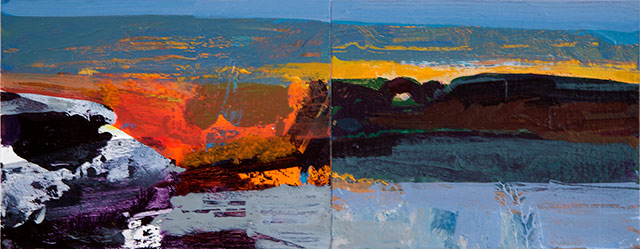N ature has always been a favorite source of inspiration for painters, and abstract landscapes are compelling. To create art abstracted from nature you start with something “real” and then pull it and stretch it into something new, in order to express your feelings or your interpretation.
Mitchel Albala says, "There is a great misunderstanding in contemporary abstraction — that because it’s non-representational, anything goes. This could not be further from the truth. Good abstract art employs the same formal principles that great representational art does — line, form, shape, value, movement, composition, color, etc. It is the proper use of these forces that make a work of art successful. The only difference between representational painting and abstract painting is that in abstract work, the subject plays a more recessive role."1. Simply
The visual world is filled with complexity and detail. Simplification can eliminate extraneous information to reveal simpler patterns and shapes.
2. Magnify
You can enlarge a small part of an object. Choosing a close-in vantage points is a direct way to simplify. Magnification allows yout to communicate delicate qualities the viewer may not notice in the object’s actual size. Georgia O’Keeffe is famous for her magnified interpretations of organic flowers. Each are cropped to a point where the flower is almost unrecognizable.3. Brushwork
The observable world is not filled with bold or expressive mark-making and strokes - this is only found in paintings. In the observable world, most everything is rendered in crisp sharpness and detail. When strokes become bolder, looser, and more expressive, greater attention is brought to the mark and the surface itself. We are adding a dimension to the painting that doesn’t exist in reality. The painting becomes more about the paint. Recognizable forms begin to dissolve and abstraction is induced.
4. Color alteration
Albala says: "One of the ways we identify representational imagery is through color, e.g., Trees are green. Skies are blue. If we shift colors away from what we understand to be representational, then we can induce abstraction. One of the most common ways artists do this is to use highly saturated or intense color. The world is not as colorful as “high key” as expressive colorists would have us believe. In fact, it’s filled largely with neutral colors, punctuated occasionally with moments of saturated color. Highly saturated color, spread across the entire picture, is not a “realistic” expression of the natural world. For that reason, when added to our paintings, it can heighten the abstraction. (Note: Even in abstract work, saturated color everywhere can be overpowering, offering no visual relief. As Sir Kenneth Clark said,“All color is no color.”)
5. FlatnessRepresentational painting uses the illusion of a three-dimensional space. When we disrupt this spatial illusion by flattening the space, then our associations to the representational narrative will also begin to dissolve. This doesn’t mean that abstract work cannot suggest depth, however. With abstract work, you have the option to play with the spatial illusion by reinforcing it or suppressing it. Making a painting flat is more difficult that making it spatial. When making an abstract picture, therefore, flatness is often the byproduct of applying the other modes.
6. Exaggerate
You can accentuate the parts of a landscape you like best, maybe using the colors and certain forms, but it is not the landscape as we actually see it. It has been transformed, exaggerated to meet with your personal artistic vision.3. Distort
Surrealism and Cubism are great examples of movements in art history that were known for distortion. Nature wasn’t used exclusively as inspiration for these movements, but was often prevalent. Distorting the proportions of an object or certain qualities can cause abstract visual stimulation that opens doors to new thinking.See Albala's Modes of Abstraction here

Rebecca Allan, Fault Line, Anza Road, 2011, acrylic on paper, 6 x 12 inches. Expressive brushwork is one means to induce abstraction. In this In this small painting, inspired by the volcanic forces of the earth, the brushwork is so bold and directly stated that it becomes an an aesthetic force that is elevated to a status greater than the implied landscape.
Comments
Post a Comment